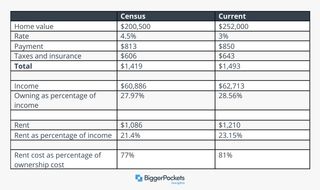Do Hot Markets Affect Renter Demand? Case Study: Charlotte, NC

The residential rental market has been en fuego for the better part of the past decade—in fact, I’d wager that a great many people reading this article have spent their entire REI career in this bull market.
But regardless of whether you’re a brand-new investor or an old hat with hundreds of doors, it’s important to understand how hot markets can affect renter demand. Smart investors can use this knowledge to help decide between two markets—or make an informed decision about when to invest.
How did we get here?
Every bull market is driven by unique characteristics. From a rental demand perspective, our current bull market kicked off during the 2008 recession. Millions of people had no choice but to rent, due to their inability to obtain a mortgage.
Extremely low interest rates and a large stock of outdated rental units helped the supply side of the equation respond to the demand. Investors put serious capital into buying rentals, building or renovating units, and attracting new renters.
At the same time, Millennials—who came of age during the 2008 recession—saw the dangers and commitments required by home ownership. This led to a new demand for high-amenity, class-A units in great locations. Developers entered an arms race, adding bigger, better amenities—to the point where new class-A assets resemble resorts as much as apartment buildings.
Before COVID-19, Baby Boomers entering the empty nest phase of their life provided significant rental demand. They sought lifestyle free of home-ownership commitments—and close to active city centers.
Now, we’re entering another shift in demand. Today’s renters are eager to escape cities and enter the suburbs. Apparently, people prefer a little more space when there’s a virus going around. Can’t imagine why.
Some cities have also been going through some political turmoil, which has largely had a tempering effect on demand. Whether these trends are transitory or permanent remains to be seen.
Can hot markets affect renter demand?
Why yes—yes they can. Generally, we think that strong demand is what makes a market “hot,” but in some ways the hot market itself can change demand.
In a hot market, rents are constantly increasing. The option to own a home always exists for many renters, so depending on the home ownership dynamics in a given area, renting can begin to look less attractive than home ownership. In an environment with constantly rising rents, renters must deal with their already high rent going up every year and may start to think about the stability of a fixed mortgage payment and not needing to worry about moving.
As rents increase, basic economics also tell us that renters will begin looking for alternatives. Younger renters may look for two- or three-bedroom units to share with roommates, while families may move further out in the metro area, sacrificing longer commute times for lower monthly payments.
We’ve seen this changing demand manifest itself it several ways.
- Developers building increasing numbers of micro-units —buildings with units as small as approximately 160 square feet! These floorplans have been successful in some extremely hot markets, like Seattle and New York. I’d rather store an angry wolverine in my underpants, but some people like the ability to afford a unit right in the heart of the action, sacrificing space to make it work.
- Interesting rental community innovations , driven by Millennials aging into marriages and children. These innovations include units with backyards and no shared walls, stairwells, or elevators—with the benefits of renting. Renters also love the fantastic amenities, no maintenance responsibilities, and flexibility to move around. The Avilla brand and Christopher Todd Properties are good examples of this playing out. It’s extremely popular in the Phoenix market and we’re seeing it move into other parts of the sunbelt and elsewhere.
Assessing future rental demand: A case study
Let’s pick Charlotte, just for funsies. How do we assess rental demand—and use that knowledge to make good investment decisions?
At its core, demand for housing comes from population growth. The population growth of a city (over and above births) is mainly driven by job creation.
Charlotte has long been known as a financial hub and has seen continued growth in this area. Trust Financial, AvidXchange, Allstate, and MetLife—among many others—have invested hundreds of millions of dollars and brought thousands of new people into the city. The city has also attracted businesses in other sectors, with major announcements from Centene Corp, Amazon, and Lowe’s adding several thousand jobs to the market.
According to the Census Bureau, from 2010 to 2019 Charlotte grew by 17.5 percent, adding about 120 people per day.
Clearly, the demand is there. Charlotte also continues to build out transportation infrastructure and is generally friendly toward development, which should allow for continued growth.
Rent vs. own analysis
Before we dive into the numbers, a few things to keep in mind: I used Census data for information on median incomes and housing values, and I trended income, taxes, and insurance by three percent.


Despite housing values increasing, the current low interest rate climate has kept a lid on ownership costs relative to renting. That said, renting remains a good option for many, as it remains roughly 80 percent of the cost of ownership for the median income household.
Overall demand assessment
While we’ll have to keep a close eye on the fallout from the pandemic, the Charlotte market has some long-term tailwinds behind rental demand that should remain in place over the long term.
Jobs will continue to flow in given the climate, the access to talented workers, and the low-tax, business-friendly environment. Renting will continue to look like a good option for many, as continued development will enhance the rental stock and keep rents from spiking aggressively.
The supply side of the equation
If we want to understand where rents are going, we’ve also got to look at how much supply should be coming online, where it is going, and in what form.
There are estimates that around 10,000 units will be hitting the multifamily market in the next four quarters. Single-family permits are within the range seen before the housing bubble burst—the July number was about 1,800 permits, or an annual run rate of about 21,600 homes. That was a big spike, though, so we may be better served to use the 2019 average monthly rate of 1,271—or about 15,250 per year.
We can figure about 25,000 total housing units will come online over the next year or so, and we’ve seen population increasing by an average of about 43,200 per year since 2010. However, how many households does that population growth cover?
It may be true that many people moving in are young, finding new jobs, and may be a household of one. Others may be families, with an average household size closer to four or five people. We’d need to do some more research and try to narrow down on that number, but for now, let’s call the average new household size three people. With that estimate, around 14,400 households will be created in the coming year—but closer to 25,000 units will be supplied.
Drilling down further
In aggregate, Charlotte may be over-supplied in the near term. Despite strong long-term tailwinds on the demand side, there may be some short-term hiccups while people try to adjust to the new normal and potentially tighten their belts due to COVID-19.
At a high level, we may conclude that Charlotte faces short-term challenges to growing rent, while over the longer term we could expect the bull market to continue. Obviously, if macroeconomic conditions continue to deteriorate we’d need to adjust our opinions.
However, even that doesn’t tell us the whole picture. Real estate is an extremely local game, sometimes down to the asset level.
Most of the apartment supply is hitting the downtown area at a time when renters may be looking to get to the suburbs. Conversely, the single-family structures are likely going up further out where land is available.
Where are the new employers setting up shop? Where are the new transportation lines going? Are there specific areas within the MSA that would be extremely attractive to renters, and is anything being built to service them? Are renters seeking more space and single-family homes?
These answers will guide smart decisions in this market.
Now is the time to be hyper-vigilant as real estate investors. There is a lot of uncertainty out there surrounding economic conditions and rental demand. While the residential markets remain hot, conditions can change quickly. Monitor things closely, do your homework, and be flexible.
